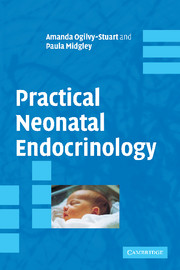Book contents
- Frontmatter
- Contents
- Acknowledgements
- Introduction
- 1 Hyperglycaemia
- 2 Hypoglycaemia
- 3 Management of hyperinsulinism
- 4 Hypoglycaemia in infant of a diabetic mother
- 5 Dysmorphic features
- 6 Micropenis
- 7 Hypopituitarism
- 8 Ambiguous genitalia (male): XY disorders of sex development
- 9 Cryptorchidism
- 10 Ambiguous genitalia (female): XX disorders of sex development
- 11 Pigmented scrotum
- 12 Adrenal failure
- 13 Collapse
- 14 Hypotension
- 15 Hyponatraemia
- 16 Hyperkalaemia
- 17 Hypernatraemia
- 18 Maternal steroid excess
- 19 Hypercalcaemia
- 20 Hypocalcaemia
- 21 Investigation and management of babies of mothers with thyroid disease
- 22 Maternal or familial thyroid disease
- 23 Goitre
- 24 Abnormal neonatal thyroid function tests
- 25 Hypothyroxinaemia in preterm infants
- Appendix 1 Calculation of glucose infusion rate
- Appendix 2 Dynamic tests
- Appendix 3 Normal ranges
- Appendix 4 Biochemistry samples
- Appendix 5 Formulary
- Index
12 - Adrenal failure
Published online by Cambridge University Press: 15 February 2010
- Frontmatter
- Contents
- Acknowledgements
- Introduction
- 1 Hyperglycaemia
- 2 Hypoglycaemia
- 3 Management of hyperinsulinism
- 4 Hypoglycaemia in infant of a diabetic mother
- 5 Dysmorphic features
- 6 Micropenis
- 7 Hypopituitarism
- 8 Ambiguous genitalia (male): XY disorders of sex development
- 9 Cryptorchidism
- 10 Ambiguous genitalia (female): XX disorders of sex development
- 11 Pigmented scrotum
- 12 Adrenal failure
- 13 Collapse
- 14 Hypotension
- 15 Hyponatraemia
- 16 Hyperkalaemia
- 17 Hypernatraemia
- 18 Maternal steroid excess
- 19 Hypercalcaemia
- 20 Hypocalcaemia
- 21 Investigation and management of babies of mothers with thyroid disease
- 22 Maternal or familial thyroid disease
- 23 Goitre
- 24 Abnormal neonatal thyroid function tests
- 25 Hypothyroxinaemia in preterm infants
- Appendix 1 Calculation of glucose infusion rate
- Appendix 2 Dynamic tests
- Appendix 3 Normal ranges
- Appendix 4 Biochemistry samples
- Appendix 5 Formulary
- Index
Summary
Clinical presentation
Hypoglycaemia (see Chapter 2).
Collapse (see Chapter 13).
Hypotension (see Chapter 14).
Ambiguous genitalia (see Chapters 8 and 10).
Skin pigmentation (commonly, but not exclusively, scrotal, see Chapter 11).
Hyponatraemia (see Chapter 15).
Approach to the problem
Assess perfusion.
Measure blood pressure.
Measure blood glucose.
Measure blood sodium and potassium.
Is there a history of asphyxia? (Bilateral adrenal haemorrhage.)
History of maternal steroid excess (therapeutic administration or Cushing's syndrome).
Differential diagnosis
Other causes of hypoglycaemia e.g. hyperinsulinism, or metabolic cause (see Chapters 2 and 3).
Other causes of circulatory collapse, e.g. sepsis (see Chapter 13).
Addisonian crisis (structural or functional absence of pituitary or adrenal glands).
Primary adrenal failure
Congenital adrenal hyperplasia (CAH, including lipoid CAH caused by an abnormality in the steroidogenic acute regulatory (StAR) protein).
Adrenal hypoplasia congenita (AHC).
Adrenoleucodystrophy (ALD).
Secondary adrenal failure
Adrenal suppression following steroid therapy.
Adrenocorticotrophic hormone (ACTH) deficiency (see Chapter 7).
ACTH resistance (familial glucocorticoid deficiency or FGD).
Antenatal steroids administered to the mother.
Maternal Cushing's disease/syndrome.
Postnatal steroid therapy.
Investigations
Immediate
Three random blood cortisol measurements (timing is not important) to look for low cortisol levels. (Plasma cortisol is difficult to interpret on a single sample because of the pulsatile nature of cortisol secretion, therefore taking 2–3 random samples makes it less likely that all will fall at a nadir. Cortisol may also be easier to interpret in the first week of life when cortisol levels are higher.)
[…]
- Type
- Chapter
- Information
- Practical Neonatal Endocrinology , pp. 83 - 92Publisher: Cambridge University PressPrint publication year: 2006

